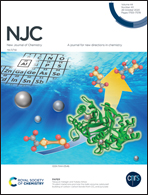Theoretical study of the surface structure of anatase nanoparticles: effect on dye adsorption and photovoltaic properties
Abstract
The properties of TiO2 can vary greatly, depending on the size and morphology of the particles used. The modeling of TiO2 nanoparticles of various diameters, and the study of their properties and morphology are of great interest for identifying the factors affecting the properties of nanoparticles. In this paper, the theoretical study based on the modeling of nanoparticles of TiO2 and the relationship between morphological parameters and calculated descriptors has been carried out. As a result of simulation, the nanoparticle structures of the composition Ti17O34–Ti568O1136 have been obtained. The surface analysis of nanoparticles has been carried out, and their density is calculated. We explained the increase in N3 dye adsorption and photovoltaic parameters with the decrease in the surface area of nanoparticles. We found that dye adsorption, short circuit photocurrent density, and power conversion efficiency are related to the solvent accessible surface area of the nanoparticle as well as the accessible surface area of oxygens.



 Please wait while we load your content...
Please wait while we load your content...